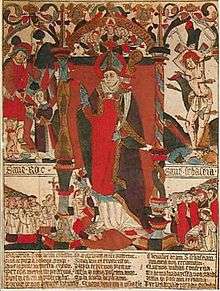Lycerius

Saint Lycerius (sometimes also Glycerius; French: Saint Lizier; Catalan: Sant Lliceri)[1] (died 548) was a bishop of Couserans in the late 5th and 6th centuries.
He is recorded as having attended the Council of Agde in 506.
After his death in 548 he was buried in what is now Saint-Lizier Cathedral and canonised. As Saint Lizier he is the patron of a number of places in south-western France, notably Saint-Lizier, where the cathedral is also dedicated to him; Saint-Lizier d'Ustou (Ariège); and Saint-Lizier-du-Planté (Gers).
His feast day is 27 August.
Lycerius is also linked with Lleida in Catalonia, where there is a tradition (undocumented) of a bishop of the same name in the 3rd century. It is not clear to what extent the Catalan traditions reflect a confusion between two separate individuals, if indeed there is any foundation to them. In Lleida his feast is celebrated on 1 September. He is the secondary patron of Lleida, and the patron of Sant Antoni de Vilamajor.
According to tradition, which cannot be verified, he was a native of Civitas Bigorra, the present Saint-Lizier, near Tarbes. He studied with the bishop of Tarbes, and later with Quintí, bishop of Rodez, who ordained him priest. On account of the sanctity of his life he was elected bishop of Couserans, and also administered the diocese of Tarbes during its vacancy from 506 to 541.
He is credited with many miracles of healing.
Lycerius is shown wearing bishop's robes standing between two bulls.
See also
Notes
- ↑ also Liceri, Lleïr, Llehí, Lleí, Lliser and Llisé
Sources
| Wikimedia Commons has media related to Lizier de Couserans. |